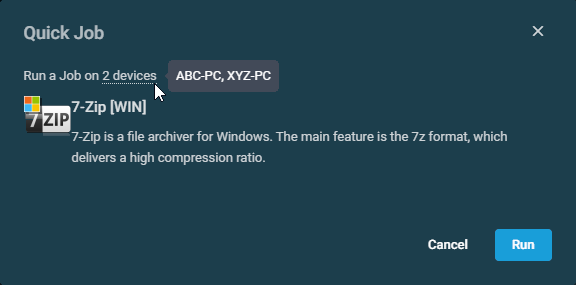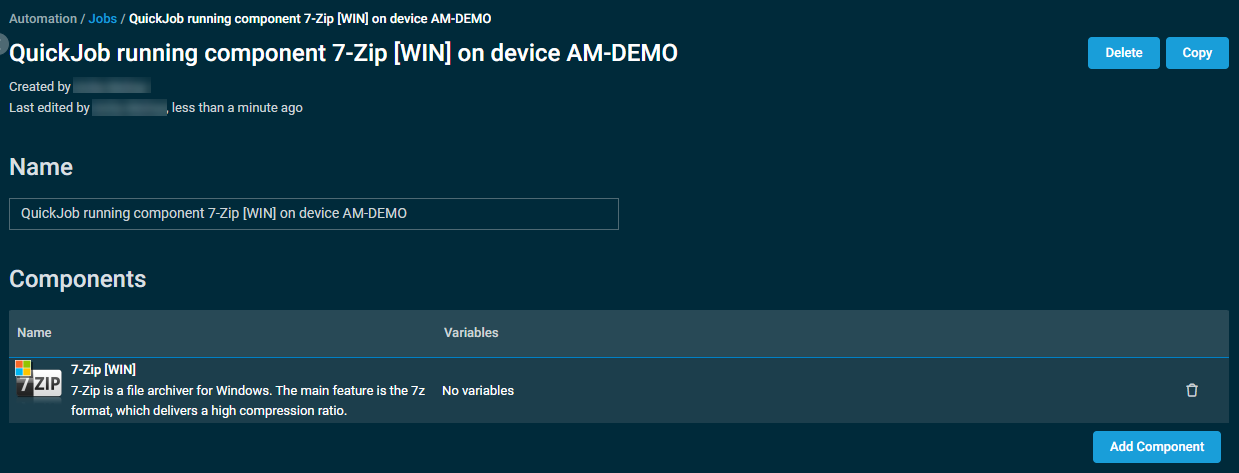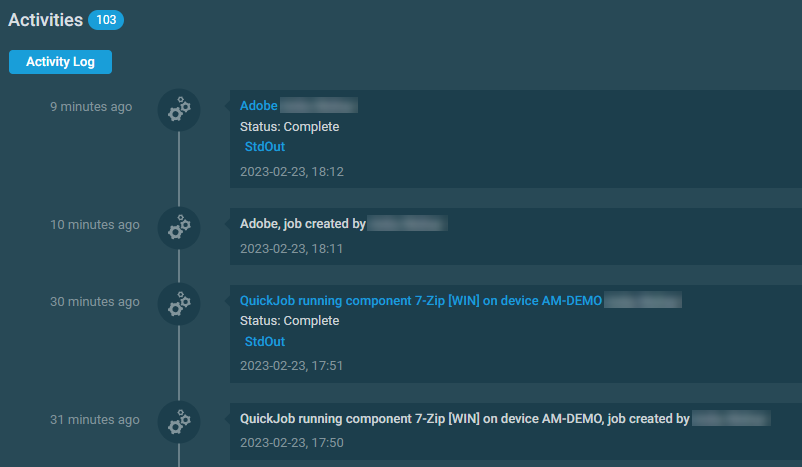Quick jobs
PERMISSIONS Refer to Jobs > Active Jobs in Permissions.
NAVIGATION Job results page > select one or more devices (check boxes) > Quick Job. To view the various navigation paths you can use to access the job results page, refer to Job results.
NAVIGATION Sites > All Sites > click the name of a site > select one or more devices (check boxes) > Quick Job
NAVIGATION Devices > All > select one or more devices (check boxes) > Quick Job
NAVIGATION Device summary page > Quick Job. To view the various navigation paths you can use to access the device summary page, refer to Device summary.
NAVIGATION A targeted list of devices > select one or more devices (check boxes) > Quick Job. To view the navigation paths for the various targeted lists of devices, refer to Targeted lists of devices in Devices.
NAVIGATION List of alerts > select one or more alerts (check boxes) > Quick Job. To view the navigation paths for the various lists of alerts, refer to Alerts.
NAVIGATION Single Alert View page > click the Alert Actions icon > Quick Job. To view the various navigation paths you can use to access the Single Alert View page, refer to Single Alert View.
NAVIGATION Automation > Jobs > Edit Job (Action column in table)
NAVIGATION Automation > Jobs > click the name of a job > Edit Job
About quick jobs
A quick job allows you to immediately deploy a component without having to create and schedule the job. Components must first be downloaded from the ComStore into your Component Library. Refer to ComStore. Components can only be added from the ComStore if you have Manage access to ComStore. Refer to ComStore in Security levels.
Quick jobs can be run only on servers or workstations.
Similar to scheduled jobs, quick jobs can be run against individual devices, sites, filters, or groups.
Quick jobs are run immediately and do not have an expiration time. They always run in the LocalSystem Account. However, it is possible to force the execution of a script to run in the context of the local user by creating a scheduled job and selecting the Run as a logged in user option within the Execution section. Refer to Execution.
NOTE Since quick jobs do not have an expiration time, they will remain in an active state for devices that are not able to receive it (for example, offline devices). If necessary, you can manually clean up quick jobs by deleting them. Refer to Delete.
How to...
- Follow any of the navigation paths described in Running a quick job.
- From the pane that opens to the right, click Select to add a component. Refer to Components.
- The confirmation dialog box that appears will indicate if you are running a quick job against more than one device. Hover over the link showing the number of devices to see a list of hostnames.

NOTE All components of the categories Applications and Scripts are available for jobs. Refer to List of components.
- Once the component is selected, you'll see its description, if available. If the component has variables, you can configure them now.
Variable value limit: 20,000 characters.
- Click Run to execute the action or Cancel to close out of the dialog box.
A pop-up notification will indicate if the job has been created successfully.
NOTE Only jobs with the Active status can be edited.
Follow any of the navigation paths described in Editing a quick job. On the Edit a Job page, complete the sections below to modify an existing job. You may also delete, retire, or copy the job by clicking the corresponding button at the top of the page.
IMPORTANT A job can only be viewed, edited, copied, deleted, or retired by users with the Administrator security level or a user with the same security level as the one that was used when the job was created. For example, if a job was created by a user with the Administrator security level, non-administrator users will be unable to view, edit, copy, delete, or retire that job.
| Field | Description |
|---|---|
| Name | Change the name of the job. Refer to Name. NOTE An edited job name appears on the job results page after the next job is run. Refer to Job results. For existing Initial Audit jobs, name edits are not reflected. |
| Components | Add, remove, or change the order of components the job will run. Refer to Components. |
| Targets | Add or remove targets the job will run against. Refer to Targets. |
| Schedule | Configure a schedule for the job. Refer to Schedule. |
| Notification | Configure email notifications for the job. Refer to Notification. |
| Execution | Choose how to run the job. Refer to Execution. |
| Enabled/Disabled | Enable or disable the job. |
| Save the Job | When you are finished, click Save to save the changes to the job, or select Cancel to discard the changes. A dialog box will confirm whether you are sure you wish to edit this job. Click OK to save your changes. A dialog box will confirm that the changes have been saved successfully. Otherwise, click Cancel. |
Jobs and their statuses can be viewed from the Jobs page. Refer to Jobs overview. They are also displayed in the Activities card on the device summary page. Refer to Activities.
Click a hyperlinked job name to be directed to the job results page. Refer to Job results.



